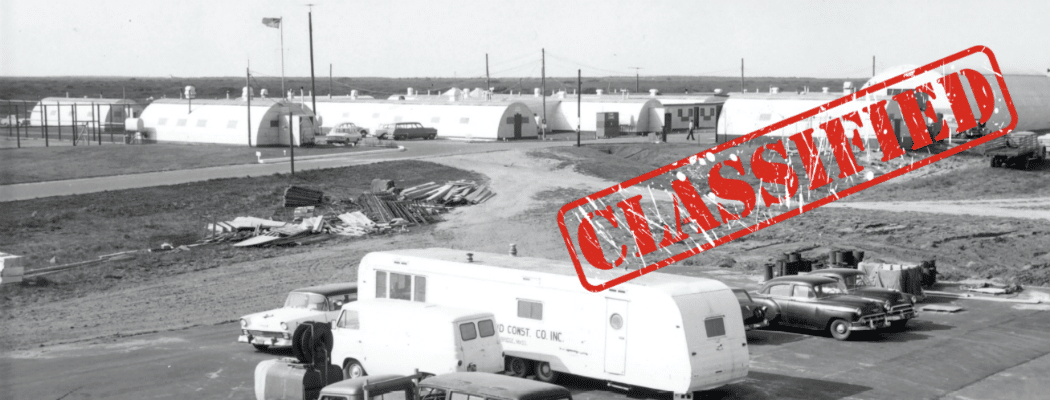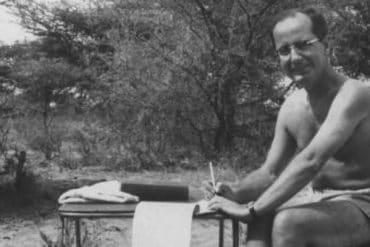Nantucket’s old Navy Base was the site of a sophisticated surveillance operation.
As a kid in 1955, Robert Young was hanging around his family’s Steamboat Wharf bike shop when he spotted a distinctive gray vessel pulling into the harbor. Young didn’t know it, but the U.S. Navy had arrived on Nantucket. They would stay for the next two decades, leaving behind a handful of former Navy men who took part—directly and indirectly—in a top-secret mission that continues to captivate history buffs like Young.
 The mission tracked the movements of potentially hostile Soviet submarines through underwater microphones. At the time, sound surveillance was an “audacious concept,” wrote electrical engineer Edward Whitman, who worked on the science behind the project and served the Navy for forty years as a civilian. “It was one of the most impressive engineering feats of the early Cold War.”
The mission tracked the movements of potentially hostile Soviet submarines through underwater microphones. At the time, sound surveillance was an “audacious concept,” wrote electrical engineer Edward Whitman, who worked on the science behind the project and served the Navy for forty years as a civilian. “It was one of the most impressive engineering feats of the early Cold War.”
The Seabees construction battalion colonized forty-five acres on Tom Nevers Head, a spit of land on Nantucket’s south shore with a sheer drop to the Atlantic. They threw together sheet-metal structures that shone silver in the sun to house and feed dozens of young sailors pouring in from California, Kentucky, Ohio and Virginia. Among them was Don Miller. At nineteen, he and a friend set out to sign up for the Marines in their hometown of Yakima, Washington. They ended up in the Navy, and after Miller finished a building course, he found himself shipped off to a naval facility on a Massachusetts island he had never heard of. There, he nailed together Quonset huts in which he and other early recruits braved the first chilly winter.
 Later, he and other Seabees helped build barracks, a rec center, a water tower, a substation, a vehicle repair shop, a skeet house and an ammo bunker. To tame the relentless dust, they planted grass that became a softball diamond. Operations took on Officers, Maintenance—Miller’s assigned division—challenged the Supply corps. They played against local teams. Sailors spent weekends on the beach, catching and grilling fish. At bars on Main Street, a shot was a quarter, a pack of cigarettes was 10 cents. The enlistees, barely older than boys, sometimes drove too fast, crashing cars on Milestone Road.
Later, he and other Seabees helped build barracks, a rec center, a water tower, a substation, a vehicle repair shop, a skeet house and an ammo bunker. To tame the relentless dust, they planted grass that became a softball diamond. Operations took on Officers, Maintenance—Miller’s assigned division—challenged the Supply corps. They played against local teams. Sailors spent weekends on the beach, catching and grilling fish. At bars on Main Street, a shot was a quarter, a pack of cigarettes was 10 cents. The enlistees, barely older than boys, sometimes drove too fast, crashing cars on Milestone Road.
In 1957, a year after the Tom Nevers Naval Facility was commissioned, The Inquirer and Mirror noted that a vice admiral and a rear admiral had arrived on Nantucket to see how the “oceanographic research” was progressing. An oversized Quonset hut on the bluff was known as the terminal building, or T-building. “Whatever they did in that building, they took an oath not to talk about it. Even if you were with buddies having a beer, they wouldn’t talk about it,” recalls Ray Moores, who arrived at Tom Nevers in 1964 when he was twenty-two, right out of boot camp.

For a time in the sixties, Young worked as a milkman. At the cinderblock guardhouse—still standing at a different location and covered in graffiti—he was stopped and interrogated by armed Navy personnel. “Come on, guys,” he used to think. “Don’t you want your milk and eggs?”
One night, Moores used a beer can opener called a church key to jimmy the lock on the T-building. “The next thing I knew, a .45 was at my head,” says Moores, now seventy-six. “I thought I was going to die.” When Miller was once granted access to fix a broken floorboard, he was watched over by a soldier wielding what looked like a submachine gun. Those were the only times Moores and Miller ever saw the inside of the T-building until its demolition.
Jimmy Cooper, on the other hand, was inside the T-building almost every day. Growing up in Cambridge, Massachusetts, Cooper enlisted at seventeen and spent time on a destroyer before being trained in sonar and getting security clearance for the highly classified work going on inside the T-building—work that he and others called oceanography research but was actually Cold War intelligence on submarines, destroyers and tankers—anything with a propeller.

Each shift, Cooper would walk by the enlisted man with the .45, down a hallway and into a room lined with instruments receiving signals from arrays of underwater microphones on the ocean floor. Twenty-four hours a day, thirty stylists skittered across graph paper inscribing undulating patterns that represented an array’s low-frequency sound output along a given beam direction. Identifying characteristic frequencies was key to detecting and classifying targets. After a while, Cooper could identify individual subs by the sound pattern they created.
In the next room, radiomen encrypted the data and relayed it to the next station in Cape May, New Jersey, or to Washington, D.C. Electricians stood by to maintain the equipment. By the early 1960s, undersea listening posts formed a semicircle from Barbados to Nova Scotia—a secret weapon that enabled U.S. forces to keep track of potentially hostile submarines operating in the deepwater regions off both coasts. Meanwhile, Miller, Moores and everyone else on the base—as well as everyone on Nantucket—were kept in the dark.
 In 1976, Tom Nevers Naval Facility was decommissioned. The town purchased the land three years later for $525,000. The Quonset huts made their way around the island: one at Don Allen Ford, others housing caddies at Sankaty Head Golf Club. Erosion ate away a quarter mile of what was once the upper base; the T-building would have plunged down the bluff if it were still intact. The softball field is still there.
In 1976, Tom Nevers Naval Facility was decommissioned. The town purchased the land three years later for $525,000. The Quonset huts made their way around the island: one at Don Allen Ford, others housing caddies at Sankaty Head Golf Club. Erosion ate away a quarter mile of what was once the upper base; the T-building would have plunged down the bluff if it were still intact. The softball field is still there.
Nuclear submarines became too quiet to detect through sonar. Sound surveillance systems are now used to study hydrothermal vents, pinpoint underwater volcanic eruptions and listen to whales vocalizing. In the 1950s, because the underwater signals traveled through cables only up to 150 miles long, sound surveillance stations such as Tom Nevers had to be located where the continental shelf is closest to land. Cooper, Moores and Miller ended up on Nantucket because of science and a sandbar. They stayed because they fell in love—with women they met here, and with the island itself.

Moores, from Worcester, Massachusetts, got married after his Navy stint and bought a house near Surfside. He’s been here fifty-five years. Miller moved to California for a time with his first wife, Marsha, the daughter of Nobby Clothes Shop owners Samuel and Renee Levine. He came back, divorced and remarried, and designed and built four houses, including his current home on Fairgrounds Road. Miller, now eighty-three, has three children, nine grandchildren and one great-grandchild. Cooper was married for ten years and has two kids. After attending Northeastern University, he returned to Nantucket and ran a plumbing business.
Young, a self-described history nut, is glad Miller and the others can now tell their stories. “I appreciate the fact that this little island where I grew up had a top-secret military base,” he says. “No one in the community had any idea.”







